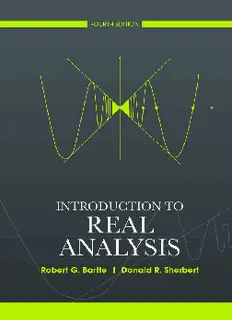Table Of ContentThis page intentionally left blank
FFIRS 12/15/2010 10:13:22 Page1
Introduction to Real Analysis
This page intentionally left blank
FFIRS 12/15/2010 10:13:22 Page3
INTRODUCTION TO REAL ANALYSIS
Fourth Edition
Robert G. Bartle
Donald R. Sherbert
University of Illinois, Urbana-Champaign
John Wiley & Sons, Inc.
FFIRS 12/15/2010 10:13:22 Page4
VP&PUBLISHER LaurieRosatone
PROJECTEDITOR ShannonCorliss
MARKETINGMANAGER JonathanCottrell
MEDIAEDITOR MelissaEdwards
PHOTORESEARCHER SheenaGoldstein
PRODUCTIONMANAGER JanisSoo
ASSISTANTPRODUCTIONEDITOR YeeLynSong
COVERDESIGNER SengPingNgieng
Thisbookwassetin10/12TimesRomanbyThomsonDigital,andprintedandboundbyHamiltonPrinting
Company.ThecoverwasprintedbyHamiltonPrintingCompany.
Foundedin1807,JohnWiley&Sons,Inc.hasbeenavaluedsourceofknowledgeandunderstandingformore
than200years,helpingpeoplearoundtheworldmeettheirneedsandfulfilltheiraspirations.Ourcompanyis
builtonafoundationofprinciplesthatincluderesponsibilitytothecommunitiesweserveandwhereweliveand
work.In2008,welaunchedaCorporateCitizenshipInitiative,aglobalefforttoaddresstheenvironmental,
social,economic,andethicalchallengeswefaceinourbusiness.Amongtheissuesweareaddressingarecarbon
impact,paperspecificationsandprocurement,ethicalconductwithinourbusinessandamongourvendors,and
communityandcharitablesupport.Formoreinformation,pleasevisitourwebsite:www.wiley.com/go/
citizenship.
Thisbookisprintedonacid-freepaper.(cid:1)1
Copyright#2011,2000,1993,1983JohnWiley&Sons,Inc.Allrightsreserved. Nopartofthispublication
maybereproduced,storedinaretrievalsystemortransmittedinanyformorbyanymeans,electronic,
mechanical,photocopying,recording,scanningorotherwise,exceptaspermittedunderSections107or108of
the1976UnitedStatesCopyrightAct,withouteitherthepriorwrittenpermissionofthePublisher,or
authorizationthroughpaymentoftheappropriateper-copyfeetotheCopyrightClearanceCenter,Inc.222
RosewoodDrive,Danvers,MA01923,websitewww.copyright.com. RequeststothePublisherforpermission
shouldbeaddressedtothePermissionsDepartment,JohnWiley&Sons,Inc.,111RiverStreet,Hoboken,NJ
07030-5774,(201)748-6011,fax(201)748-6008,websitehttp://www.wiley.com/go/permissions.
Evaluationcopiesareprovidedtoqualifiedacademicsandprofessionalsforreviewpurposesonly,foruseintheir
coursesduringthenextacademicyear. Thesecopiesarelicensedandmaynotbesoldortransferredtoathird
party. Uponcompletionofthereviewperiod,pleasereturntheevaluationcopytoWiley. Returninstructionsand
afreeofchargereturnshippinglabelareavailableatwww.wiley.com/go/returnlabel.OutsideoftheUnited
States,pleasecontactyourlocalrepresentative.
LibraryofCongressCataloging-in-PublicationData
Bartle,RobertGardner,1927-
Introductiontorealanalysis/RobertG.Bartle,DonaldR.Sherbert.–4thed.
p. cm.
Includesindex.
ISBN978-0-471-43331-6(hardback)
1. Mathematicalanalysis. 2. Functionsofrealvariables. I. Sherbert,DonaldR.,1935-II. Title.
QA300.B2942011
515–dc22 2010045251
PrintedintheUnitedStatesofAmerica
10 9 8 7 6 5 4 3 2 1
FDED01 12/08/2010 15:42:42 Page5
A TRIBUTE
This edition is dedicated to the memory of Robert G. Bartle, a wonderful friend and
colleagueoffortyyears.IthasbeenanimmensehonorandpleasuretobeBob’scoauthor
on the previous editions of this book. I greatly miss his knowledge, his insights, and
especially his humor.
November 20, 2010
Urbana, Illinois Donald R. Sherbert
FDED02 12/08/2010 15:43:51 Page6
To Jan, with thanks and love.
FPREF 12/09/2010 14:45:10 Page7
PREFACE
The study of real analysis is indispensable for a prospective graduate student of pure or
appliedmathematics.Italsohasgreatvalueforanystudentwhowishestogobeyondthe
routine manipulations of formulas because it develops the ability to think deductively,
analyze mathematical situations and extend ideas to new contexts. Mathematics has
become valuable in many areas, including economics and management science as well
as the physical sciences, engineering, and computer science. This book was written to
provideanaccessible,reasonablypacedtreatmentofthebasicconceptsandtechniquesof
real analysis for students in these areas. While students will find this book challenging,
experience has demonstrated that serious students are fully capable of mastering the
material.
The first three editions were very well received and this edition maintains the same
spirit and user-friendly approach as earlier editions. Every section has been examined.
Somesectionshavebeenrevised,newexamplesandexerciseshavebeenadded,andanew
sectionontheDarbouxapproachtotheintegralhasbeenaddedtoChapter7.Thereismore
materialthancanbecoveredinasemesterandinstructorswillneedtomakeselectionsand
perhaps use certain topics as honors or extra credit projects.
To provide some help for students in analyzing proofs of theorems, there is an
appendix on ‘‘Logic and Proofs’’ that discusses topics such as implications, negations,
contrapositives,anddifferent typesofproofs.However,itis amoreuseful experienceto
learn how to construct proofs by first watching and then doing than by reading about
techniques of proof.
Resultsandproofsaregivenatamediumlevelofgenerality.Forinstance,continuous
functionsonclosed,boundedintervalsarestudiedindetail,buttheproofscanbereadily
adapted to a more general situation. This approach is used to advantage in Chapter 11
where topological concepts are discussed. There are a large number of examples to
illustratetheconcepts,andextensivelistsofexercisestochallengestudentsandtoaidthem
in understanding the significance of the theorems.
Chapter1hasabriefsummaryofthenotionsandnotationsforsetsandfunctionsthat
willbeused.AdiscussionofMathematicalInductionisgiven,sinceinductiveproofsarise
frequently. There is also a section on finite, countable and infinite sets. This chapter can
usedtoprovidesomepracticeinproofs,orcoveredquickly,orusedasbackgroundmaterial
and returning later as necessary.
Chapter2presentsthepropertiesoftherealnumbersystem.Thefirsttwosectionsdeal
with Algebraic and Order properties, and the crucial Completeness Property is given in
Section 2.3 as the Supremum Property. Its ramifications are discussed throughout the
remainder of the chapter.
In Chapter 3, a thorough treatment of sequences is given, along with the associated
limit concepts. The material is of the greatest importance. Students find it rather natural
though it takes time for them to become accustomed to the use of epsilon. A brief
introduction to Infinite Series is given in Section 3.7, with more advanced material
presented in Chapter 9.
vii
FPREF 12/09/2010 14:45:10 Page8
viii PREFACE
Chapter4onlimitsoffunctionsandChapter5oncontinuousfunctionsconstitutethe
heart of the book. The discussion of limits and continuity relies heavily on the use of
sequences,andthecloselyparallelapproachofthesechaptersreinforcestheunderstanding
oftheseessentialtopics.Thefundamentalpropertiesofcontinuousfunctionsonintervals
arediscussedinSections5.3and5.4.ThenotionofagaugeisintroducedinSection5.5and
used to give alternate proofs of these theorems. Monotone functions are discussed in
Section 5.6.
ThebasictheoryofthederivativeisgiveninthefirstpartofChapter6.Thismaterialis
standard,exceptaresultofCarath(cid:1)eodoryisusedtogivesimplerproofsoftheChainRule
and the Inversion Theorem. The remainder of the chapter consists of applications of the
Mean Value Theorem and may be explored as time permits.
In Chapter 7, the Riemann integral is defined in Section 7.1 as a limit of Riemann
sums. This has the advantage that it is consistent with the students’ first exposure to the
integralincalculus,andsinceitisnotdependentonorderproperties,itpermitsimmediate
generalizationtocomplex-andvector-valuesfunctionsthatstudentsmayencounterinlater
courses. It is also consistent with the generalized Riemann integral that is discussed in
Chapter 10. Sections 7.2 and 7.3 develop properties of the integral and establish the
Fundamental Theorem of Calculus. The new Section 7.4, added in response to requests
from a number ofinstructors, develops the Darboux approach to the integral in terms of
upperandlowerintegrals,andtheconnectionbetweenthetwodefinitionsoftheintegralis
established. Section 7.5 givesa brief discussion of numerical methods of calculating the
integral of continuous functions.
Sequencesoffunctionsanduniformconvergencearediscussedinthefirsttwosections
of Chapter 8, and the basic transcendental functions are put on a firm foundation in
Sections8.3and8.4.Chapter9completesthediscussionofinfiniteseriesthatwasbegun
in Section 3.7. Chapters 8 and 9 are intrinsically important, and they also show how the
material in the earlier chapters can be applied.
Chapter10isapresentationofthegeneralizedRiemannintegral(sometimescalledthe
‘‘Henstock-Kurzweil’’orthe‘‘gauge’’integral).Itwillbenewtomanyreadersandthey
willbeamazedthatsuchanapparentlyminormodificationofthedefinitionoftheRiemann
integral can lead to an integral that is more general than the Lebesgue integral. This
relativelynewapproachtointegrationtheoryisbothaccessibleandexcitingtoanyonewho
has studied the basic Riemann integral.
Chapter11dealswithtopologicalconcepts.Earliertheoremsandproofsareextended
to a more abstract setting. For example, the concept of compactness is given proper
emphasis and metric spaces are introduced. This chapter will be useful to students
continuing on to graduate courses in mathematics.
Therearelengthylistsofexercises,someeasyandsomechallenging,and‘‘hints’’to
many of them are provided to help students get started or to check their answers. More
complete solutions of almost every exercise are given in a separate Instructor’s Manual,
which is available to teachers upon request to the publisher.
It is a satisfying experience to see how the mathematical maturity of the students
increasesastheygraduallylearntoworkcomfortablywithconceptsthatinitiallyseemed
somysterious.Butthereisnodoubtthatalotofhardworkisrequiredonthepartofboththe
students and the teachers.
Briefbiographicalsketchesofsomefamousmathematiciansareincludedtoenrichthe
historicalperspectiveofthebook.ThanksgotoDr.PatrickMuldowneyforhisphotograph
ofProfessorsHenstockandKurzweil,andtoJohnWiley&Sonsforobtainingportraitsof
the other mathematicians.

